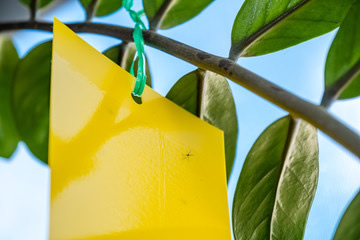What are sticky bug traps? How effective are sticky bug traps?
By Fillinx Solutions

What are sticky bug traps? How effective are sticky bug traps?
What are sticky bug traps?
Sticky traps work well for catching pests like cockroaches, spiders, and other crawling insects as well as mites and scorpions. For trapping flying insects like bed bugs, sticky traps are less effective. The best option is to use yellow insect traps.
Sticky traps can be used to periodically check a location for scurrying insects. Because of this, experts frequently use them to enhance their ability to discover bugs during pest-control- control inspections. An investigator can apply sticky traps to locate pests that are nocturnal at times when there is no activity.

Why Use Sticky Traps ?
How to Place Sticky Bug Traps
The number of traps you own and their positioning are the two most crucial factors when using sticky traps to eliminate insects from your home. This increases the probability that insects will come in contact with the sticky traps and be trapped by them. Try to be aware of your pest problem before purchasing sticky traps. Take note of the insects you’re addressing and the locations on your property where they’re most active. You’ll place the majority of your baits in these locations.
One sticky trap every five to ten feet is the suggested distance. Sticky traps should be placed by the owner’s manual, but also with the accompanying positioning advice:
- Install Traps Along Pest Pathways – Most pests wander around the edges of a property or in locations that are concealed from view. This implies that sticky traps can be found in areas like floorboards, corners of rooms, underneath equipment, under cabinets, and near garbage cans. Apply your insights to influence your position even further.

- Maintain a Dust-Free Environment – Dust particles will adhere to the glue trap, yielding it useless against insects. Do a good cleaning before placing a bait, and maintain it clean while the trap is in position. A different pest control method might be necessary if your space is typically dusty.
- Choose Protected Areas – Sticky traps can attract plant insects and outdoor insects in enclosed areas. However, you should only use them in enclosed spaces such as greenhouses, warehouses, garages, and covered patios. In most unprotected outdoor spaces, there are far too many insects and even less control around them to make sticky traps a realistic alternative. You’re also more likely to find useful bugs.

- Keep Children and Animals Away – Even though sticky traps are usually non-toxic, it is wise to keep children and animals away from them. This prevents insects from being disturbed and interfering with your pest management efforts. The scent of glue or other bug-attracting ingredients may lure pets to consume the bait, which might make them sick.
After you place your glue traps, you will want to check them regularly. If traps have amassed a significant number of bugs or are starting to look dusty, trade them out for a new clean track. This will keep your traps working as effectively as possible as you eliminate bugs.
Features of Sticky Bug Traps
Sticky Traps: Bright yellow colours attract flying insects, and high-quality glue keeps them from escaping. It is specially designed for flying plant pests. And it’s Great for outdoor or indoor plants, especially potted plants.

Safe: glue to catch pests, odourless, no harm to people and pets.
Easy to Use: Easily peel it and insert it in the plant pot or the fruit without sticky hands. Suitable for a houseplant, a home kitchen, or a garden.
Long last: Upgraded strong adhesive so they are UV resistant and waterproof. No need to replace them until fully covered with bugs

Wide Application: Specially designed to attract and trap any insect pest that lands on it. Suitable for kitchen, pantry, potted plants or for outdoors, garden, and other vulnerable places.


